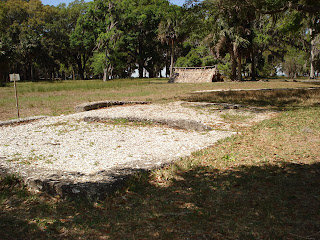 Christ Episcopal Church of Fredrica ca. 1808
Christ Episcopal Church of Fredrica ca. 1808 Building began in 1808, though I did find a headstone in the church yard from 1803. During the Civil War, Union troops used the church partly for stables and nearly destroyed the church. Rebuilt with fabulous stained glass, some of it from Tiffany's.
Building began in 1808, though I did find a headstone in the church yard from 1803. During the Civil War, Union troops used the church partly for stables and nearly destroyed the church. Rebuilt with fabulous stained glass, some of it from Tiffany's.  During the Lent season
During the Lent season Stained Glass.....Orb to the right. Interesting
Stained Glass.....Orb to the right. Interesting
The Cemetery is spectacular! Peaceful, serene with centuries of moss, overgrowth and some decay eating away at wrought iron.


 A sitting chair that is decaying with time.
A sitting chair that is decaying with time. During three hundred years a tree grew through the iron, had been chopped down and now is rotting along with the iron.
During three hundred years a tree grew through the iron, had been chopped down and now is rotting along with the iron. Survived the American Revolution, to drown off the coast of St. Simons Island.
Survived the American Revolution, to drown off the coast of St. Simons Island. The oldest found stone.
The oldest found stone. A Confederate Soldier who died in the Battle of Manassas
A Confederate Soldier who died in the Battle of Manassas
Fort Frederica
 A scale model of what the town and fort would have looked like in the 1740's - 1780's
A scale model of what the town and fort would have looked like in the 1740's - 1780's Fort Frederica was built in the 1730's to act as an buffer and to protect from the Spanish colony of St. Augustine, just downstream. The Spanish and English became enbroiled in the War of Jenkins Ear. The Battle of Bloody Marsh and Battle of Gully Hole Creek were fought not too far from this spot.
Fort Frederica was built in the 1730's to act as an buffer and to protect from the Spanish colony of St. Augustine, just downstream. The Spanish and English became enbroiled in the War of Jenkins Ear. The Battle of Bloody Marsh and Battle of Gully Hole Creek were fought not too far from this spot.  Relics excavated from the spot
Relics excavated from the spot
After the War of Jenkins Ear, Fort Frederica became a bustling town with several hundred residents.
 This is Broad Street - the main thoroughfare through the village. The village had candlemakers, doctors, meat markets, cordwainers and all the occupations needed to keep a village thriving. However, excavations showed that many of the homes endured severe fires in the 1780's. Cause is unknown. It is not known if the cause was due to an invasion, carelessness or any other reason. Shortly thereafter, the population of the village began to wane off.
This is Broad Street - the main thoroughfare through the village. The village had candlemakers, doctors, meat markets, cordwainers and all the occupations needed to keep a village thriving. However, excavations showed that many of the homes endured severe fires in the 1780's. Cause is unknown. It is not known if the cause was due to an invasion, carelessness or any other reason. Shortly thereafter, the population of the village began to wane off.  Ecavations of the site produced these artifacts.
Ecavations of the site produced these artifacts.  Home sites that were excavated.
Home sites that were excavated.  The Tavern Keeper and the Doctor had a side by side house that had a shared fireplace.
The Tavern Keeper and the Doctor had a side by side house that had a shared fireplace. 
 The Candlemakers house.
The Candlemakers house.  What is left of the actualy Fort Frederica. Notice the British flag flying. The Fort and village thrived before 1780 when the area is still technically British. The Americans had not quite won Independence yet.
What is left of the actualy Fort Frederica. Notice the British flag flying. The Fort and village thrived before 1780 when the area is still technically British. The Americans had not quite won Independence yet. 
 The Fort is in the background while the store house is in the fore ground.
The Fort is in the background while the store house is in the fore ground.  Canons overlook the water.
Canons overlook the water. 
The Olde Burial Ground
 The sign mentions that Mr. Oglethorpe had passed through the area on multiple occasions as he headed to his plantation. The Wesley brothers, who began the Methodist religion and lived in the area, presided over several funeral services in this cemetery. No records exist of those folks who reside in the burial ground. Time has also taken its toll and little exists of the graves.
The sign mentions that Mr. Oglethorpe had passed through the area on multiple occasions as he headed to his plantation. The Wesley brothers, who began the Methodist religion and lived in the area, presided over several funeral services in this cemetery. No records exist of those folks who reside in the burial ground. Time has also taken its toll and little exists of the graves. 




No comments:
Post a Comment